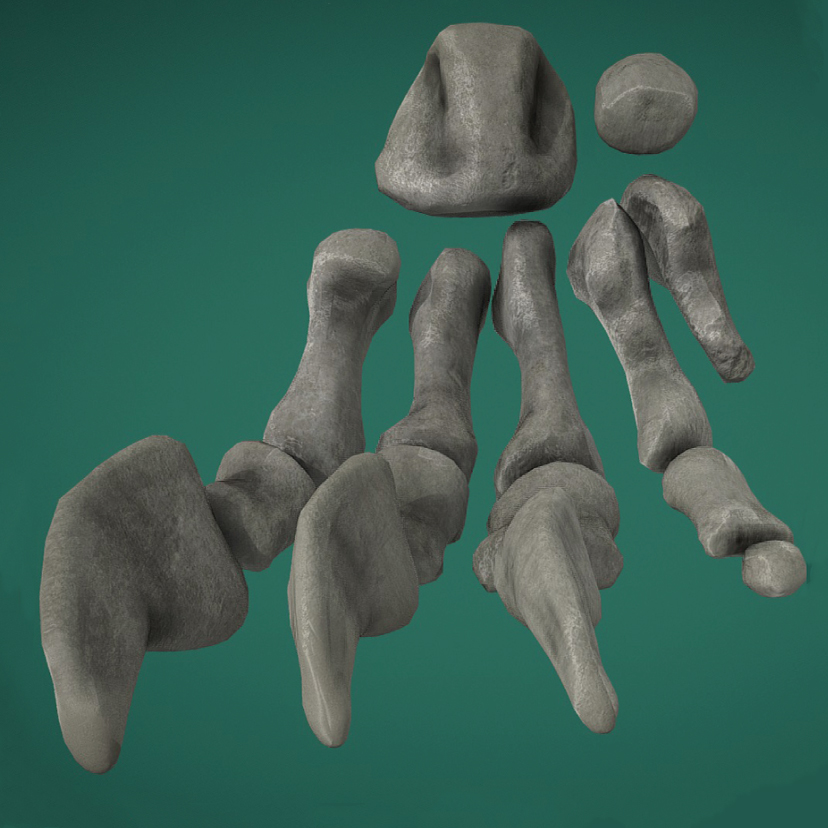A GUIDE TO THE RECONSTRUCTION OF THE AUTOPODIA OF TETRAPODA THROUGH 3D TECHNOLOGY: THE CASE OF NEUQUENSAURUS AUSTRALIS (SAUROPODA: TITANOSAURIA)
DOI:
https://doi.org/10.5710/PEAPA.04.10.2023.483Keywords:
Scanner, 3D model, Retrodeformation, Museo de La Plata, 3D printing, DinosauriaAbstract
This contribution presents a detailed methodology for reconstructing the anterior and posterior autopodia (manus and pes elements) of the sauropod dinosaur Neuquensaurus australis. The study utilizes various techniques, including digital three-dimensional (3D) scanning, reconstruction, retrodeformation, scaling, texturing, rendering, 3D printing, and mounting, to create accurate representations of the fossil elements. Two different scanning devices were employed to capture high-resolution 3D models of the fossil elements. The scanned data was processed to align and fuse the points, resulting in detailed 3D models. Related taxa such as Argyrosaurus superbus and 3D modeling techniques were used to reconstruct missing elements. Scaling calculations were performed based on comparative analysis with other titanosaurs to estimate the size of the missing elements. Retrodeformation was applied to correct taphonomic distortion and restore the original shape of the fossil elements. Texturing and rendering techniques were also employed to enhance the visual quality of the 3D models. The 3D models were subsequently 3D printed using white polylactic acid (PLA) filament. Creating physical replicas is useful for further studies, educational purposes, and public outreach. We highlight the advantages of 3D printing in paleontology, such as cost-effectiveness and accessibility, as it creates accurate replicas without compromising the original fossils. Overall, the presented methodologies demonstrate the potential of 3D technologies in paleontological research. The combination of scanning, reconstruction, retrodeformation, scaling, texturing, rendering, and 3D printing provides a comprehensive approach to accurately reconstructing and visualizing fossil elements. These techniques contribute to a better understanding of extinct vertebrates and their biomechanics.
References
Apesteguía, S. (2004). Bonitasaura salgadoi gen. et sp. nov.: a beaked sauropod from the Late Cretaceous of Patagonia. Naturwissenschaften, 91, 493–497.
Arbour, V. M. & Currie, P. J. (2012). Analyzing taphonomic deformation of ankylosaur skulls using retrodeformation and finite element analysis. PLoS ONE, 7(6), 1–13. https://doi.org/10.1371/journal.pone.0039323
Borsuk-Bialynicka, M. (1977). A new camarasaurid sauropod Opisthocoelicaudia skarzynskii gen. n., sp. n. from the Upper Cretaceous of Mongolia. Palaeontologia Polonica, 37(5), 5–64.
Boyd, A. A. & Motani, R. (2008). Three-dimensional re-evaluation of the deformation removal technique based on ‘‘jigsaw puzzling’’. Palaeontologia Electronica, 11(2), 7A.
Breithaupt, B. H., Matthews, N. A. & Noble, T. A. (2003). An integrated approach to three-dimensional data collection at dinosaur tracksites in the Rocky Mountain West. Ichnos, 11(1–2), 11–26. https://doi.org/10.1080/10420940490442296
Cheng, L., Antonenko, P. D., Ritzhaupt, A. D., Dawson, K., Miller, D., MacFadden, B. J., ... & Ziegler, M. (2020). Exploring the influence of teachers' beliefs and 3D printing integrated STEM instruction on students’ STEM motivation. Computers & Education, 158, 103983.
Cunningham, J. A., Rahman, I. A., Lautenschlager, S., Rayfield, E. J. & Donoghue, PC. J. (2014). A virtual world of paleontology. Trends in Ecology & Evolution, 29(6), 347–357. https://doi.org/10.1016/j.tree.2014.04.004.
Curry Rogers, K. & Forster, C. A. (2001). The last of the dinosaur titans: a new sauropod from Madagascar. Nature, 412(6846), 530–534.
Cuvier, G. (1796). Notice sur le squelette d’une très grande espèce de quadrupède inconnue jusqu’à présent, trouvé au Paraquay, et déposé au cabinet d’histoire naturelle de Madrid. Magasin encyclopédique, ou Journal des Sciences, des Lettres et des Arts, 1, 303–310; 2, 227–228
Díez Díaz, V., Demuth, O., Schwarz, D. & Mallison, H. (2020). The Tail of the Late Jurassic Sauropod Giraffatitan brancai: Digital Reconstruction of Its Epaxial and Hypaxial Musculature, and Implications for Tail Biomechanics. Frontiers in Earth Science, 8(160). 10.3389/feart.2020.00160.
Dunlavey, T. (2008). Image interpretation is important to paleontology? Case studies in data acquisition, fidelity, and retrodeformation using bilaterally symmetric graptolite (Isograptus and Pseudisograptus) and trilobite (Triarthrus beckii and eatonii) fossils. PhD Thesis, State University of New York at Buffalo]. Retrieved from https://www.proquest.com/openview/dc67934b81090978e3f7fe465606b024/1?pq-origsite=gscholar&cbl=18750
Gonzalez Riga, B. J. (2003). A new titanosaur (Dinosauria, Sauropoda) from the Upper Cretaceous of Mendoza province, Argentina. Ameghiniana, 40(2), 155–172.
Grant, C. A., MacFadden, B. J., Antonenko, P. & Perez, V. J. (2016). 3-D Fossils for k–12 education: A case example using the giant extinct shark Carcharocles megalodon. The Paleontological Society Papers, 22, 197–209.
Hatcher, J. B. (1901). Diplodocus (Marsh): Its osteology, taxonomy, and probable habits, with a restoration of the skeleton. Memoirs of the Carnegie Museum, 1, 1–63.
Hutchinson, J. R., Anderson, F. C., Blemker, S. S. & Delp, S. L. (2005). Analysis of hindlimb muscle moment arms in Tyrannosaurus rex using a three-dimensional musculoskeletal computer model: implications for stance, gait, and speed. Paleobiology, 31(4), 676. https://doi.org/10.1666/04044.1
Hutchinson, J. R. & Garcia, M. (2002). Tyrannosaurus was not a fast runner. Nature, 415(1), 1018–1021. https://doi.org/10.5926/jjep1953.34.1_84
Janensch, W. (1950). The Vertebral Column of Brachiosaurus brancai. Palaeontographica, 1(3), 27–93.
Johnson, E. H. & Carter, A. M. (2019). Defossilization: a review of 3D printing in experimental paleontology. Frontiers in Ecology and Evolution, 7, 430.
Klinkhamer, A. J., Wilhite, D. R., White, M. A. & Wroe, S. (2017). Digital dissection and three-dimensional interactive models of limb musculature in the Australian estuarine crocodile (Crocodylus porosus). PLoS ONE, 12(4), 17–22. https://doi.org/10.1371/journal.pone.0175079
Lacovara, K. J., Lamanna, M. C., Ibiricu, L. M., Poole, J. C., Schroeter, E. R., Ullmann, P. V., ... & Novas, F. E. (2014). A gigantic, exceptionally complete titanosaurian sauropod dinosaur from southern Patagonia, Argentina. Scientific Reports, 4(1), 6196.
Lautenschlager, S. (2016). Reconstructing the past: Methods and techniques for the digital restoration of fossils. Royal Society Open Science, 3(10). https://doi.org/10.1098/rsos.160342
Lydekker, R. (1893). The dinosaurs of Patagonia. Anales Del Museo de La Plata, 2, 1–14.
Mallison, H. (2010a). CAD assessment of the posture and range of motion of Kentrosaurus aethiopicus Hennig 1915. Swiss Journal of Geosciences, 103(2), 211–233. https://doi.org/10.1007/s00015-010-0024-2
Mallison, H. (2010b). The digital Plateosaurus I: Body mass, mass distribution and posture assessed using cad and cae on a digitally mounted complete skeleton. Palaeontologia Electronica, 13(2), 1–26.
Mallison, H. & Wings, O. (2014). Photogrammetry in paleontology—a practical guide. Journal of Paleontological Techniques, 12(12), 1–31.
Motani R. (1997) New technique for retrodeforming tectonically deformed fossils, with an example for ichthyosaurian specimens. Lethaia, 30, 221–228.
Otero, A. & Gasparini, Z. (2014). The history of the cast skeleton of Diplodocus carnegii Hatcher, 1901, at the Museo de la Plata, Argentina. Annals of Carnegie Museum, 82(3), 291–304.
Otero, A., Moreno, A. P., Falkingham, P. L., Cassini, G., Ruella, A., Militello, M. & Toledo, N. (2020). Three-dimensional image surface acquisition in vertebrate paleontology: a review of principal techniques. Publicación Electrónica de la Asociación Paleontológica Argentina, 20(1), 1–14. http://dx.doi.org/10.5710/PEAPA.04.04.2020.310
Paul, G. S. & Chase, T. L. (1989). Reconstructing extinct vertebrates. In: E.R.S. Hodges (ed.), The Guild Handbook of Scientific Illustration, 239–256. Van Nostrand Reinhold, New York.
Peterson, J. E. & Krippner, M. L. (2019). Comparisons of fidelity in the digitization and 3D printing of vertebrate fossils. Journal of Paleontological Techniques, 22, 1–9.
Rahman, I. A., Adcock, K. & Garwood, R. J. (2012). Virtual fossils: a new resource for science communication in paleontology. Evolution: Education and Outreach, 5, 635–641.
Reiss, S. & Mallison, H. (2014). Motion range of the manus of Plateosaurus engelhardti von Meyer, 1837. Palaeontologia Electronica, 17(1), 1–19.
Schlager, S., Profico, A., Di Vincenzo, F. & Manzi, G. (2018). Retrodeformation of fossil specimens based on 3D bilateral semi-landmarks: Implementation in the R package “Morpho”. PloS ONE, 13(3), e0194073. https://doi.org/10.1371/journal.pone.0194073
Stevens, K. A. (2013). The Articulation of Sauropod Necks: Methodology and Mythology. PLoS ONE, 8(10), e78572. https://doi.org/10.1371/journal.pone.0078572
Stevens, K. A. & Parrish, J. M. (1999). Neck posture and feeding habits of two Jurassic sauropod dinosaurs. Science, 284, 798–800. doi: 10.1126/science.284.5415.798
Steyer, J. S., Boulay, M. & Lorrain, S. (2010). 3D external restorations of stegocephalian skulls using Zbrush: the renaissance of fossil amphibians. Comptes Rendus Palevol, 9(6–7), 463–470.
Sutton, M. D., Rahman, I. A.& Garwood, R. J. (2014). Techniques for Virtual Palaeontology. John Wiley & Sons.
Vidal, D. & Díez Díaz, V. (2017). Reconstructing hypothetical sauropod tails by means of 3D digitization: Lirainosaurus astibiae as case study. Journal of Iberian Geology, 43(2), 293–305. https://doi.org/10.1007/s41513-017-0022-6
Wedel, M. J. (2003a). The evolution of vertebral pneumaticity in sauropod dinosaurs. Journal of Vertebrate Paleontology, 23, 344–357.
Wedel, M. J. (2003b). Vertebral pneumaticity, air sacs, and the physiology of sauropod dinosaurs. Paleobiology, 29(2), 243–255. https://doi.org/10.1017/S0094837300018091
Xing, L., Ye, Y., Shu, C., Peng, G. & You, H.-L. (2009). Structure, orientation and finite element analysis of the tail club of Mamenchisaurus hochuanensis. Acta Geologica Sinica, 83(6), 1031–1040.
Zollikofer, C. P. E. & de León, M. S. P. (2005). Virtual Reconstruction. A primer in computer-assisted paleontology and biomedicine. Wiley..

Additional Files
Published
Issue
Section
License
Copyright (c) 2024 Agustín Roberto Ruella, Agustín Pérez Moreno, Yanina Herrera

This work is licensed under a Creative Commons Attribution-NoDerivatives 4.0 International License.
Authors retain copyright and grant the journal right of first publication with the work simultaneously licensed under a Atribución/Reconocimiento 4.0 Internacional that allows others to share the work with an acknowledgement of the work's authorship and initial publication in this journal.















